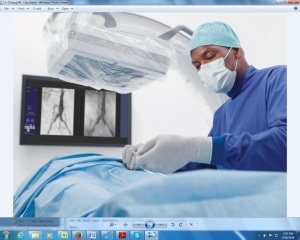by
Lauren Dubinsky, Senior Reporter | April 09, 2014

Cios Alpha, image
courtesy of Siemens Healthcare
From the April 2014 issue of HealthCare Business News magazine
Since the first mobile C-arm for use in surgery was launched commercially in 1955 by C.H.F. Müller GmbH, a part of the German Philips Medical Systems organization, the technology has come a long way.
The global market is expected to reach $2.6 billion by 2018, according to a Global Industry Analysts Inc. report published last year. The main triggers of this demand are enhanced image resolution and radiation dose reduction due to flat panel detectors.
Additionally, hospitals are looking to become as efficient as possible while cutting costs. Vendors are listening to their customers and responding by delivering the requested solutions. They created a variety of new features to try to improve workflow and integrating the C-arms with other systems has become the latest trend.
Integral integration
“I think the integration of different machines in an operating system or maybe even in a hospital is at the current forefront of technological advancement,” says Jon Snyder, chief technology officer for GE Healthcare’s surgery business. “It becomes very interesting when you start looking at the other devices in an OR and you look for the integration of them to create value, which is greater than that of either device by itself.”
The company has taken what it calls its “first step” in integrating mobile Carms with other systems. At RSNA 2012 it unveiled its OEC 9900 Elite mobile C-arm mounted within the workstation of the Venue 40 tablet ultrasound, which is the first mobile C-arm integrated with an ultrasound.
“The logic was—we can see that there are two devices which are providing value in the surgery suite and they’re providing different kinds of information,” says Snyder. “But the question that we ask is—is there value in bringing those two devices into one?”
Since this is such a new concept, GE is still in the process of learning how useful integrating the two systems is, but they believe that it will bring a lot of benefits.
One of the main potential benefits is freeing up space in the operating room. Space is such an important commodity in an operating room and any opportunity to conserve it is welcomed.
By integrating the systems, it frees up floor space and also requires fewer cords on the floor, which allows staff to clean up and turnover the operating room much faster.
Fresenius Vascular Care in Louisiana purchased the system recently and they say this is a big plus. “With the space savings, everything is combined right there so you don’t have to hide another piece of equipment or try to fit another piece of equipment somewhere close to the table in a confined place. Everything is kind of hidden in the console itself so it’s nice,” says Scott Bonvillain, interventional radiologic technologist at the facility.
